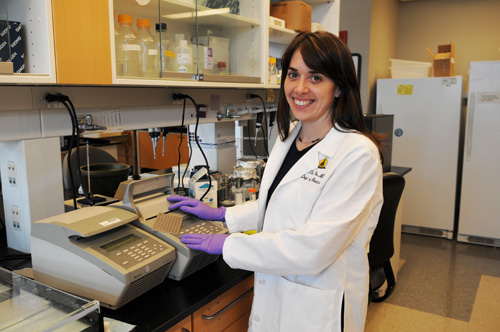Last month we reviewed one strategy to overcome a major obstacle to an AIDS cure—the persistent reservoirs of virus that are impervious to standard anti-HIV drugs. That approach involved activating, or “shocking,” the latent cells, inducing production of HIV that is susceptible to killing by standard drugs. This month we bring you the work of three groups of amfAR funded scientists, all seeking to better understand and implement the “shock and kill” strategy.

Dr. Christine Durand
First, Drs. Uri Mbonye and Jonathan Karn at Case Western Reserve University review in the journal Virology the multiple molecular mechanisms the virus uses to suppress its own genes. Normally the virus would receive powerful signals to keep it growing, but in rare cases it becomes silent instead, thus avoiding destruction by either antiretroviral therapy or the immune system. Mbonye and Karn emphasize that multiple avenues of research seeking to uncover the details of these control pathways are under way and “should inform the development of optimal combinatorial reactivation strategies that are intended to purge the latent viral reservoir.”
One group taking on this challenge included Dr. Christine Durand, working with Drs. Janet and Robert Siliciano at Johns Hopkins University. Reporting in Nature Medicine, they describe a new test system for analyzing chemical agents discovered through the screening of thousands of compounds from so-called “chemical libraries.” These libraries, consisting of compounds originally developed to treat other diseases or developed by scientists studying things like chemical structures, have been searched to identify compounds reported to be capable of activating latent virus in test-tube models.
Rather than using standard test-tube models, Durand and associates tested these compounds in latently infected cells taken straight from HIV-infected patients on antiretroviral therapy. And they made a critical discovery: current test-tube models “do not fully recapitulate mechanisms governing HIV-1 latency in vivo.” In other words, they don’t accurately reflect how reservoirs of virus develop and persist in the human body. Scientists have long hoped that drugs might be found that could activate HIV without activating cells hosting the virus—something that would probably lead to many untoward side effects. These new findings, however, suggest that such non-activating agents, at least if used alone, would be unlikely to help eliminate HIV from a patient.
Finally, Dr. Robert Siliciano led a team examining drugs already FDA-approved for non-HIV/AIDS uses for their capacity to inhibit specific stages in the HIV life cycle, including gene expression, virus assembly, and HIV’s eventual budding out of an infected cell. These are all processes not targeted by most current anti-HIV medications. Surprisingly, as reported in the Journal of Antimicrobial Chemotherapy, they found that some common heart medications related to digitalis (derived from the foxglove plant) had such effects. We look forward to further research in this area.
Dr. Laurence is amfAR’s senior scientific consultant and Dr. Johnston is vice president and director of research.